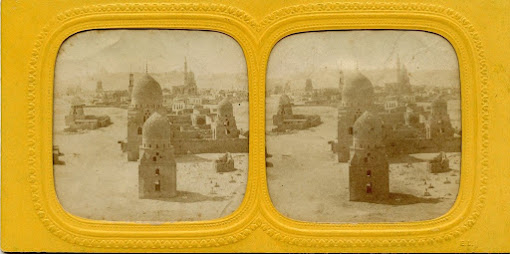Here is a self portrait by 19th century photographer of Middle Eastern scenes Felix Bonfils. He was one of the earliest commercial photographers of the monuments of Egypt, Greece and Palestine with this articles focus being Egyptian monuments. The cards in question are from about c.1875 free of tourists and many of these sites are unexcavated. These cards are known as stereoviews which were meant to be viewed with a stereocope. The era of the stereoscope is from approximately c.1860 to c.1939. Felix Bonfils images were available as tourist souvenirs as individual photos and in books as well as stereoviews. I have not corrected spelling from the quotes.
Card 42). Temple of Denderah, The Temple of Tentyris
The description on the back gives the information that the temple was a relatively late construction being begun in the Ptolemaic era and finished by Nero with the portico being built under Tiberious. 19th century Egyptologist M. Maspero says of the goddess Hathor whom the temple is for "represents beauty, order, and harmony; it is through her that all is renewed and subsists.
Card 47). Triumphal Gate
"The statues of Rameses are buried in sand up to the breast", "and are very much mutilated like most statues of this description are. They are sitting statues and seem to have a total height of 13 meters." The scenes and inscription on the pylon refer to a campaign of Rameses and gives a date more than 100 years before modern Egyptologists give for the reign of Rameses II.
Card 56). Dromos - Basement-Hall and Obelisk
"The gate of the second vestibule is 20 meters broad and 60 meters high; it opens on the great basement hall, or hall of pillars constructed in the reign of Seti, father and predecessor of Rameses II. It is the largest which exist in any of the Egyptian monuments." "The vertical walls of 30 meters high are decorated with religious pictures. The sculpture of this imposing vestibule belongs to the reign of Rameses II," We are again given an inaccurate date for the reign of this king.
70. Great Temple of Medinet-Abou
"The way to the ((Kings' Gate)) (Biban-el-Molouk), branches off to the left from a point where four roads meet, about a hundred meters north of the temple of Kournak. The plain is bounded here by ranges of steep calcareous hills, the rocky slopes of which have been roughly shaped into walls and pierced by numerous rows of sepulchres. These excavations are generally of small dimensions and decorated with sculpture. Their openings look, from a distance, like the windows of an immense building."
79. Thebes - Second Hall of the Ramesseum
"This hall is 41 meters wide and 31 deep. It is entered by three gates of black granite. The lateral walls are in ruins. The ceiling was supported by 48 columns arranged in 8 lines; but only five of these lines have remained upright. The ceiling was painted with golden stars on a blue ground."
84. Thebes - Rock Cut Sepulchres
"The great temple of Medinet-Abou is the work of Ramesess III was, like the temple of Tutmes, dedicated to Ammon, the solar God of Thebes. The first pylon, obstructed by ruins, leads to a court, 34 meters wide by ..." (Wrong description), While the number on the front and back of the card is 84 clearly this is a description of the temple of Ramesses. Sadly for me this descriptive mistake is on perhaps my favorite of the stereoviews. The subject is one of the Theban cemeteries probably Sheik-abd el-Gourna. Fun to see how it looked back in the late 1860,s early 1870,s. Sure doesn't look like that anymore. Love it!
107. Propylon of The Temple of Isis
In my incomplete collection I am particularly rich in cards from the Island of Philae. "The temple of Isis was begun in the reign of Ptolemy Philadelphus (285 - 247B.C.) and finished by his successor Ptolemy Euergetes (247 - 222 B.C.)" "An inscription traced under its gate in 1799 informs us that the French army under Desaix, pursuing the Mamelucks, after the battle of the pyramids, reached Philae on the 13th of Vendemiaire in the year VII of the Republic (oct. 4th 1798). Fragments of obelisks and lions in red granite lie scattered about in front of the gateway."
114.Front and 115. Back; General View of the Temple of Phylae
"The worship of Isis maintained itself here as late as the close of the Sixth century after Christ. A Greek inscription of the chamber of Osiris, on the terrace of the great temple, proves that on the year 453 of our era the goddess Isis still had her college of priests there. It was only in 577 that the worship of Isis was abolished and the Christian religion took its place. Bishop Theodore placed the Temple under the patronage of St-Stephen."
132. Nubia - Perspective of the Temple of Kalabcheh
A number of these stereoviews are missing their back descriptions including this card again another favorite. A Roman period construction which in the 1960's the temple of Kalabcheh was rescued from the rise of the waters of lake Nassar with the help of Germany, and, in gratitude, the Egyptian government gave one of the temples gates to Germany which is somewhere in some museum in Berlin.
136.Front and 135. Back; Temple of Dakkeh
"It was founded by Ptolemy Philadelphus by Ergamenus King of Ethiopia, and continued by Philopator, Euregetes and Augustus. Here Petronius in his march on Napata, (B.C 23) defeated the troops of Candace, queen of the Ethiopians. The sculptures were covered with mud, which preserved them. In this temple was found a very curious monolith, an inscription relative to the gold mines of the desert.























